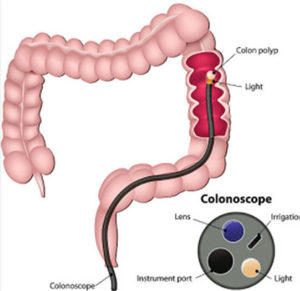What to Expect:
Before your procedure you will be interviewed by a Registered Nurse. She will ask some questions about your symptoms, health history and take your blood pressure, pulse and temperature. If you do not know them by name, please bring a list of your allergies and current medications. The nurse will also insert a small needle into a vein in your arm if your are receiving sedation. If you do not receive sedation for this test you may go home as soon as your procedure is completed. If you received sedation, after your procedure you will be sleepy. You can expect to feel bloated or crampy and pass gas from your rectum. This is just air that was pumped in through the scope during your procedure and you should not be embarrassed to pass it. Your blood pressure and pulse will be monitored frequently. You will stay in the recovery area until you are alert and oriented and your vital signs are stable, usually about one hour after your sedation was given. You may be drowsy for a few hours after you go home. Your doctor will talk to you or the person who came with you before you go home. If biopsies were taken, it will take 3-4 days to get the report. You will receive written discharge instructions and appropriate teaching materials before you leave. If you received sedation, you will not be able to drive for the rest of the day and should not plan on working the day of your test.



 Lower G. I. Endoscopy is a direct examination of your entire colon. A colonoscopy is a soft, flexible instrument, about the diameter of a finger, with a light and lens at the end which allows your doctor to see into your colon. Prior to the procedure, you will be given a mild sedative. The tube-like instrument is then inserted into the rectum and advanced through the colon so that visual inspection can be carried out. During the procedure you will be laying on your left side. While the procedure is being performed you may be asked to turn on your back or right side. This is to help the scope pass through the turns in your colon easier. Your doctor can take samples from the colon lining including biopsies and brushings, if needed. This sampling is not painful. Certain treatments may also be given through the scope as in the case of gastrointestinal bleeding or the removal of polyps. You may have a sensation of bloating or gas as air is pumped into the colon for better visualization. You may also feel some cramping. If you experience any discomfort during the procedure, additional sedation or pain medication may be given. During the procedure your blood pressure, pulse and breathing will be monitored.
Lower G. I. Endoscopy is a direct examination of your entire colon. A colonoscopy is a soft, flexible instrument, about the diameter of a finger, with a light and lens at the end which allows your doctor to see into your colon. Prior to the procedure, you will be given a mild sedative. The tube-like instrument is then inserted into the rectum and advanced through the colon so that visual inspection can be carried out. During the procedure you will be laying on your left side. While the procedure is being performed you may be asked to turn on your back or right side. This is to help the scope pass through the turns in your colon easier. Your doctor can take samples from the colon lining including biopsies and brushings, if needed. This sampling is not painful. Certain treatments may also be given through the scope as in the case of gastrointestinal bleeding or the removal of polyps. You may have a sensation of bloating or gas as air is pumped into the colon for better visualization. You may also feel some cramping. If you experience any discomfort during the procedure, additional sedation or pain medication may be given. During the procedure your blood pressure, pulse and breathing will be monitored.